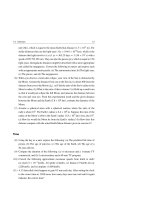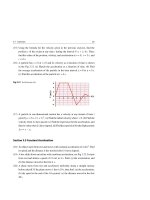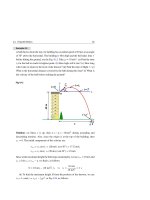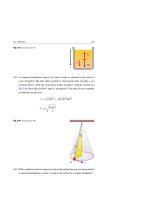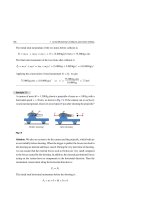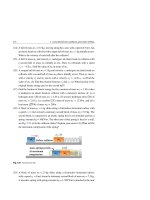Hafez a radi, john o rasmussen auth principles of physics for scientists and engineers 20
Bạn đang xem bản rút gọn của tài liệu. Xem và tải ngay bản đầy đủ của tài liệu tại đây (448.95 KB, 20 trang )
470
14.4
14 Oscillations and Wave Motion
The Speed of Waves on Strings
String waves are the most common examples of transverse waves. Let us consider a
single symmetrical pulse traveling with a speed v in a stretched string that is under
a tensional force of magnitude τ (we use the symbol τ to represent tension, which
avoids confusion with the symbol T used to represent the period of oscillation), see
Fig. 14.16. We assume that the string has a linear mass density μ = m/L, where m is
the mass of the string and L is its length.
Δs
τ
Δs
r
r
r
O
O
Fig. 14.16 A symmetrical pulse moving to the left on a stretched string with speed v. To find this speed
we apply Newton’s second law on a small segment of length
s located at the top of the pulse.
∗ Consider a small segment at the top of the pulse, of length
s, forming an arc of
a circle of radius r, see Fig. 14.16. A force equal in magnitude to the string tension τ
pulls tangentially on this segment at each end. The horizontal components of these
forces cancel, but the vertical components add to form a radial restoring force of
magnitude:
Fr = 2τ sin θ ≈ 2τ θ = τ 2θ = τ
where we have used the approximation sin θ ≈ θ when
used the relation s = r × (2θ ).
The mass m of the segment s is given by:
m=μ s
s
r
(14.41)
s is very small and also
(14.42)
14.4 The Speed of Waves on Strings
471
According to Fig. 14.16, the string segment
s is moving radially toward the
center of a circle of radius r with a centripetal acceleration of magnitude given by:
ar =
v2
r
(14.43)
When we apply Newton’s second law force = mass × acceleration, i.e. Fr =
m ar , and also apply Eqs. 14.41–14.43, we get the following relation:
τ
s
r
=μ s×
v2
r
Solving this equation for the speed v yields:
v=
τ
μ
(14.44)
This equation tells us that the speed of a wave along an ideal stretched string depends
only on the characteristics of the string (the magnitude of the tension τ and the mass
per unit length μ) and not on the frequency f of the wave. Actually, the frequency f
is fixed by whatever generates the wave, while the wavelength is fixed by Eq. 14.38,
i.e. by the relation λ = v/ f .
Example 14.5
A uniform string has a linear mass density of 0.2 kg/m. The string passes over a
massless frictionless pulley to a block of mass m = 4 kg, see Fig. 14.17. Find the
speed of a single pulse sent from one end of the string toward the pulley.
At time t
τ
mg
Fig. 14.17
Solution: The magnitude of the tension τ in the string is equal to the magnitude
of the weight of the suspended block. Thus:
472
14 Oscillations and Wave Motion
τ = mg = (4 kg) × (9.8 m/s2 )
= 39.2 N
Using this result and the linear density μ = 0.2 kg/m in Eq. 14.44, we find the
value of the speed of the wave to be:
v=
=
14.5
τ
μ
39.2 N
= 14 m/s
0.2 kg/m
Energy Transfer by Sinusoidal Waves on Strings
Waves transport kinetic and potential energy when they propagate through a medium.
This can be easily demonstrated by hanging an object on a stretched string and
then sending a pulse through it, see Fig. 14.18. As the pulse meets the object, the
object will move up and hence acquire kinetic and potential energy.
(a)
(b)
Fig. 14.18 (a) A pulse traveling on a stretched string over which an object is hung. (b) Kinetic energy
and potential energy are transferred to the object when the pulse arrives
Consider a string of mass per unit length μ and tension of magnitude τ that
is connected to a source of vibration as shown in Fig. 14.19a. When the source
vibrates, it does work to produce a sinusoidal wave that travels to the right as shown
in Fig. 14.19b. Now, let us focus our attention on an element of the string of mass
m and length x located at a particular point x. This element will move up and
down in a simple harmonic motion, see Fig. 14.19b.
Assume the oscillation of this element in the y direction has an amplitude A, wave
number k, and angular frequency ω. Then, according to Eq. 14.28, the transverse
velocity vy (not to be confused with the wave velocity v) at a particular position x
will be:
14.5 Energy Transfer by Sinusoidal Waves on Strings
vy =
dy
dt
=
x=constant
473
∂y
∂ [A sin(kx − ω t)]
=
∂t
∂t
(14.45)
= −ω A cos(kx − ω t)
t=0
V
(a)
Source of
vibration
y
Δx
A
Δm
V
x
x
time t
(b)
Fig. 14.19 (a) A source of vibration connected to a stretched string under tension τ . (b) A snapshot of
a traveling harmonic wave on the string at a time chosen to be at time t
The kinetic energy
be given by:
K associated with a string element of mass
K=
1
2
m vy2 = 21 μ x vy2
m = μ x will
(14.46)
When allowing x to approach zero, this relation becomes a differential relationship
and will take the following form:
dK = 21 μ dx vy2 = 21 μω2 A2 cos2 (k x − ω t) dx
(14.47)
At a given instant, let us integrate this expression over all the string elements
of a complete wavelength, which will give us the total kinetic energy Kλ in one
wavelength:
λ
Kλ =
dK =
2 2
1
2 μω A
cos2 (k x − ω t) dx
(14.48)
0
∗ If
we take a snapshot at time t = 0, then we can evaluate the above integral by
performing the following steps:
474
14 Oscillations and Wave Motion
x=λ
z=kλ=2π
cos2 (k x) dx =
cos2 z dz
1
k
x=0
z=0
2π
=
1
2 [1 + cos 2z]
1
k
dz
0
=
1
2k
z+
=
1
2k
(2π +
=
λ
2
1
2
sin 2z
1
2
(14.49)
2π
0
sin 4π ) − 0 =
λ
2π
4π
where we have used z = kx, cos2 z = (1 + cos 2z)/2 and k = 2π/λ to arrive to the
above result. Of course, we get the same answer if we perform the above steps at any
other time different from zero. When we substitute the above result into Eq. 14.48,
we get:
Kλ = 41 μω2 A2 λ
(14.50)
A similar analysis to the total potential energy Uλ in one wavelength will give exactly
the same result. Thus:
Uλ = 41 μω2 A2 λ
(14.51)
The total energy in one wavelength of the wave is the sum of the obtained kinetic
and potential energies:
Eλ = Kλ + Uλ = 21 μω2 A2 λ
(14.52)
As the sinusoidal wave travels along the string, that amount of energy (Eλ ) will
cross any given point on the string during a time interval equal to one period of the
oscillation. Thus, the rate of energy (or power) transferred by the wave through the
string is:
P=
Eλ
E
=
t
T
Therefore:
P = 21 μω2 A2
λ
T
14.5 Energy Transfer by Sinusoidal Waves on Strings
475
Using the relation v = λ/T given by Eq. 14.38, we finally attain the following form:
P = 21 μvω2 A2
(14.53)
In this expression the factors μ and v depend on the material and tension of the
string. On the other hand, the factors ω and A depend on the source that generates the
sinusoidal wave. The dependence of the power of a wave on the square of its angular
frequency and on the square of its amplitude is a general result, i.e. true for all wave
types.
Example 14.6
A string that is taut under tension of magnitude τ = 40 N has a linear density μ
of 64 g/m. A wave is traveling along the string with a frequency f of 120 Hz and
amplitude A of 8 mm. (a) Find the speed of the wave. (b) What is the rate of energy
that must be supplied by a generator to produce this wave in the string? (c) If the
string is to transfer energy at a rate of 500 W, what must be the required wave
amplitude when all other parameters remain the same?
Solution: (a) Equation 14.44 gives the speed of the wave as follows:
v=
τ
=
μ
40 N
= 25 m/s
0.064 kg/m
(b) First we calculate the angular frequency ω as follows:
ω = 2π f = 2 × (3.1416 rad) × (120 s−1 )
= 754 rad/s
The power supplied to the string is calculated by using the obtained values and
the given information in Eq. 14.53 as follows:
P = 21 μvω2 A2
= 21 (0.064 kg/m)(25 m/s)(754 rad/s)2 (0.008 m)2
= 29.1 W
(c) The ratio between the new power P and the old power P is:
P
=
P
1
2 2
2μ v ω A
1
2 2
2μ v ω A
=
A2
A2
476
14 Oscillations and Wave Motion
A =A
Thus:
14.6
P
500 W
= 0.008 m
= 0.033 m = 3.3 cm
P
29.1 W
The Linear Wave Equation
In Sect. 14.3.3 we introduced the wave function y = y(x, t) to represent waves traveling on strings. Actually, all these wave functions represent solutions of a differential
equation called the linear wave equation. This equation is basic to many forms of
wave motions, such as waves on strings.
We consider a single symmetrical transverse pulse that is traveling with a speed
v in a stretched ideal string under tensional force of magnitude τ and has a linear
density μ, see Fig. 14.20.
τb
y
Δ m=μ Δx
b
a
y
o
At time t
θb
Δx
θa
x
x
τa
Fig. 14.20 A pulse traveling with a speed v in a string under tension τ . The figure shows an element of
length
x at the point (x, y)
In this figure we consider a small element a b of length x with ends at angles θa
and θb with the x axis. Also, for an ideal string we consider τb cos θb = τa cos θa = τ .
Thus, with the use of this result, the net vertical force acting on the string element
can be written as:
Fy = τb sin θb − τa sin θa
= τ tan θb − τ tan θa = τ (tan θb − tan θa )
(14.54)
The tangent of an angle is represented by dy/dx when y depends only on x. Since we
are evaluating this tangent at a particular instant of time t, we need to express this
tangent in partial form as ∂y/∂x. Substituting this form of tangents into Eq. 14.54
gives:
14.6 The Linear Wave Equation
477
∂y
∂x
Fy = τ
∂y
∂x
−
b
(14.55)
a
When we apply Newton’s second law to the vertical motion of an element of mass
m = μ x, we get:
Fy =
m ay = μ
∂ 2y
∂t 2
x
(14.56)
Combining Eqs. 14.55 with Eq. 14.56, we get:
μ
x
μ
τ
∂ 2y
∂t 2
∂ 2y
∂t 2
∂y
∂x
=τ
∂y
∂x
=
∂y
∂x
−
b
∂y
∂x
−
b
a
x
a
∂y(x + x, t) ∂y(x, t)
−
∂x
∂x
=
x
(14.57)
From the definition of partial differentiation, we know that:
∂
f (x +
f (x, t) = lim
x→0
∂x
x, t) − f (x, t)
x
Thus, if we associate f (x + x, t) with (∂y/∂x)b and f (x, t) with (∂y/∂x)a , we see
that, in the limit x → 0, the right-hand side of Eq. 14.57 can be expressed as a
partial derivative as follows:
∂
∂x
∂y
∂x
= lim
∂y
∂x
−
b
x→0
∂y
∂x
a
x
√
Then, with the use of this result and Eq. 14.44, namely v = τ/μ, we can write
Eq. 14.57 as a partial differential equation in the following general form:
1 ∂ 2y
∂ 2y
− 2 2 =0
2
∂x
v ∂t
(14.58)
This is the linear wave equation as it applies to waves on strings and generally
applies to various types of traveling waves. We can prove that the sinusoidal wave
y(x, t) = A sin(kx − ω t) satisfies this equation.
14.7
Standing Waves
We consider two identical waves of the same wavelength and amplitude traveling
simultaneously in opposite directions in a stretched string. The resultant wave in
478
14 Oscillations and Wave Motion
the string will be the algebraic sum of the two waves. This is one of the examples
of a principle known as the superposition principle. Generally, this principle says
that when several effects occur simultaneously, their net effect is the sum of the
individual effects. The superposition principle will be introduced in more detail in
Chap. 15 when we study the properties of standing sound waves.
To analyze this situation, we assume that the two string waves have the same
frequency f (the same ω = 2π f ), wavelength λ (the same k = 2π/λ), and amplitude
A but travel in opposite directions. Therefore, we can write these two waves in the
following form:
y1 = A sin(k x − ω t),
y2 = A sin(k x + ω t)
(14.59)
where y1 represents a wave traveling in the positive x-direction and y2 represents a
wave traveling in the negative x-direction. The superposition of y1 and y2 gives the
following resultant:
y = y1 + y2 = A [sin(k x − ω t) + sin(k x + ω t)]
(14.60)
To simplify this expression, we use the trigonometric identity:
sin(a ± b) = sin a cos b ± cos a sin b
(14.61)
If we substitute a = kx and b = ω t in this identity, then the resultant wave y reduces
to:
y = (2 A sin k x) cos ω t
(14.62)
The resultant wave y represented by Eq. 14.62 gives a special kind of simple
harmonic motion. Here, every element of the medium oscillates in simple harmonic
motion with the same angular frequency ω (through the factor cos ω t) with an amplitude (given by the factor 2 A sin k x) that varies with position x. This wave is called a
standing wave because there is no motion of the disturbance along the x-direction.
A standing wave is distinguished by stationary positions with zero amplitudes
called nodes (see Fig. 14.21). This happens when x satisfies the condition sin kx = 0,
that is, when:
k x = 0, π, 2π, 3π, . . .
14.7 Standing Waves
479
y
When ω t = 0
When ω t = π /2
When ω t = π
A
o
2 A sin k x
A
A
A
.........x
N
N
N
N
N
Antinode = A
Node = N
λ
Fig. 14.21 The time dependence of the vertical displacement (from equilibrium) of any individual
element in the standing wave y is governed by cos ω t. Each element vibrates within the confines of the
envelope 2 A sin k x. The nodes (N) are points of zero displacement, and the antinodes (A) are points of
maximum displacement
When using k = 2π/λ, these values give x = 0, λ2 , λ, 3λ
2 , . . ., that is:
x = 0,
λ
3λ
λ
, λ,
, . . . = n , (n = 0, 1, 2, . . .)
2
2
2
(Nodes)
(14.63)
Also, a standing wave is distinguished by elements with the greatest possible displacements called antinodes (see Fig. 14.21). This happens when x satisfies the condition sin k x = ±1, that is, when:
kx =
π 3π 5π
,
,
,...
2 2
2
5λ
Also, using k = 2π/λ, these values give x = λ4 , 3λ
4 , 4 , . . ., that is:
x=
λ 3λ 5λ
λ
,
,
, . . . = (n + 21 ) , (n = 0, 1, 2, . . .)
4 4
4
2
(Antinodes)
(14.64)
Equations 14.63 and 14.64 indicate the following general features of nodes and
antinodes (see Fig. 14.21):
Spotlight
(1) The distance between adjacent nodes is λ/2.
(2) The distance between adjacent antinodes is λ/2.
(3) The distance between a node and adjacent antinode is λ/4.
At t = 0 (ω t = 0), the two oppositely traveling waves are in phase, producing
a wave pattern in which each element of the medium is experiencing its maximum displacement from equilibrium, see Fig. 14.22a. At t = T /4, (ω t = π/2),
480
14 Oscillations and Wave Motion
the traveling waves have moved one quarter of a wavelength (one to the right and the
other to the left). At this time, each element of the medium is passing through the
equilibrium position in its simple harmonic motion. The result is zero displacement
for each element at all values of x, see Fig. 14.22b. At t = T /2 (ω t = π ), the traveling
waves are again in phase, producing a wave pattern that is inverted relative to the
t = 0 pattern, see Fig. 14.22c. The pattern at t = 3T /4 (Fig. 14.22d) resembles that at
t = T /2. Also, the pattern at t = T (Fig. 14.22e) resembles that at t = 0.
y1
y1
y2
y
.
A
y1
y2
.
y2
.
A
A
. . . . .
. N N A. N
A
N N
(a) t = 0
x
. .N .N N. .N
N
(b) t = T / 4
y
y1
1
y2
y
.
A
.
. . . . . . . . . .
. N N A. N N N N N N N
A
N
(c) t = T / 2
2
.
A
A
. . . . .
. N N A. N
A
N N
(d) t = 3T / 4
(e) t = T
Fig. 14.22 Standing-wave patterns y at different times for the two oppositely traveling identical waves
y1 and y2 . Nodes (N) have no displacements while antinodes (A) have maximum displacements
Example 14.7
A standing wave is produced by two identical sinusoidal waves traveling in opposite directions in a taut string. The two waves are given by:
y1 = (0.02 m) sin(5 x − 10 t)
y2 = (0.02 m) sin(5 x + 10 t)
where x and y are in meters, t is in seconds, and the argument of the sine is in
radians. (a) Find the amplitude of the simple harmonic motion of the element on
the string located at x = 10 cm. (b) Find the positions of the nodes and antinodes
in the string. (c) Find the maximum and minimum y values of the simple harmonic
motion of a string element located at any antinode.
Solution: (a) Equation 14.62 gives the standing wave produced from y1 and y2
with A = 0.02 m, k = 5 rad/m, and ω = 10 rad/s. Thus:
y = (2 A sin k x) cos ω t = [(0.04 m) sin 5 x] cos 10 t
14.7 Standing Waves
481
The coefficient of the cosine at x = 10 cm = 0.1 m will be:
ymax = (0.04 m) sin 5 x|x=0.1 = (0.04 m) sin(0.5 rad) = 0.019 m = 1.9 cm
(b) When k = 5 rad/m = 2π/λ, we find the wavelength to be λ = 0.4π m.
Therefore, from Eq. 14.63 we find the nodes to be located at:
x=n
λ
= (0.2π n) m, (n = 0, 1, 2, . . .)
2
From Eq. 14.64, the antinodes will be located at:
x = (n + 21 )
λ
= [0.2π(n + 21 )] m, (n = 0, 1, 2, . . .)
2
(c) The maximum and minimum y values of the simple harmonic motion of a
string element located at any antinode are:
ymax/min = 2 A (sin 5 x)|max/min = 2 A (±1) = ± 0.04 m = ± 0.04 m = ± 4 cm
14.7.1 Reflection at a Boundary
A wave moving along a stretched string can be reflected from one of its ends in two
different ways, as shown in Fig. 14.23. The first way is to fix the far end of the string,
and the second way is to allow the far end to move freely up and down.
When the incident pulse in Fig. 14.23a reaches the fixed end, it exerts an upward
force on the wall through the support. By Newton’s third law, the support at the
wall exerts an opposite force on the string. This reaction force generates an inverted
reflected pulse that travels in a direction opposite to the incident pulse. In a reflection
of this kind, there must be no displacement of the string at the right end, which is
referred to as a node at the support, because the string is fixed there.
In Fig. 14.23b, the right end of the string is tied to a weightless ring that is free to
slide without friction along a vertical rod. When the incident pulse reaches the ring,
the ring moves up along the rod. The ring rises as high as the incoming pulse, and then
the downward component of the tension pulls the ring back down. This movement
of the ring produces a non-inverted reflected pulse of the same amplitude as the
incident pulse. In a reflection of this kind, there must be a maximum displacement
of the string at the right end, which is referred to as an antinode, because the string
is not fixed there.
482
14 Oscillations and Wave Motion
Fig. 14.23 (a) An incident
pulse from the left is inversely
reflected when the right side of
the string is fixed to a wall.
(b) The same incident pulse is
reflected unchanged in sign
when the right side of the
string is tied to a ring that can
slide without friction on a
vertical rod
(a)
(b)
14.7.2 Standing Waves and Resonance
When one end of a stretched string is oscillating in a sinusoidal fashion while the
other end is fixed, the incident wave and the reflected wave interfere with each other.
For certain frequencies, this interference produces a standing wave with nodes
and antinodes like those shown in Figs. 14.21 and 14.22. Such a standing wave is said
to be produced at resonance, and the string resonates at these resonant frequencies.
If the string is oscillating at some other frequency, a standing wave is not set up.
Generally, an imposed boundary condition on a string sets up a number of natural
patterns of oscillation called normal modes.
Consider a stretched string between two points separated by a distance L, see
Fig. 14.24a. Visualize that the string is somehow made to oscillate at a resonance
frequency to set up a specific standing wave pattern. Since both ends are fixed, then
for this boundary condition there must be at least two nodes and one antinode for
the standing wave pattern. The normal modes of oscillation for the string can be
explained by considering the following three patterns:
14.7 Standing Waves
483
(1) The first normal mode (the first harmonic, or the fundamental):
The simplest pattern that can meet the boundary condition of two fixed ends
is shown in Fig. 14.24b. Note that there are two imposed nodes at both ends
and only one antinode, which is at the center of the string. There is only half a
wavelength in the length L. Thus, for this pattern, λ1 /2 = L, i.e. λ1 = 2 L.
(2) The second normal mode (the second harmonic):
The second pattern that can meet the boundary condition of two fixed ends
is shown in Fig. 14.24c. This pattern has three nodes and two antinodes. This
standing wave must have λ2 = L.
(3) The third normal mode (the third harmonic):
The third pattern that can meet the boundary condition of two fixed ends is shown
in Fig. 14.24d. This pattern has four nodes and three antinodes . This standing
wave must have λ3 = 2L/3.
(a)
.
.
.
.
L
n=1
(b)
n=2
(c)
n=3
(d)
.
.
.
.
λ1= 2L
f1 =
λ1 =
2L
First
harmonic
λ2 =
L= 2 f 1
Second
harmonic
λ2 = L
f2 =
λ3= 2L 3
f3=
λ3 = 3
2L= 3 f 1
Third
harmonic
Fig. 14.24 (a) A string of length L that is fixed at both ends. The normal modes of vibration are shown
for; (b) the first harmonic (or the fundamental), (c) the second harmonic, and (d) the third harmonic
In general, the relation between the wavelength λ of the various normal modes
for a string of length L fixed at both ends is given by:
λn =
2L
, (n = 1, 2, 3, . . .)
n
(String, fixed ends)
(14.65)
484
14 Oscillations and Wave Motion
where the index n refers to the nth normal mode of the possible oscillation of the
string (or the number of loops in the string).
The resonance frequencies associated with these modes are obtained from the
relation f = v/λ, where the speed of the wave is the same for all the frequencies.
Using Eq. 14.65, we find the resonance frequencies fn of the normal modes to be
(see Fig. 14.24):
v
v
= n , (n = 1, 2, 3, . . .)
λn
2L
fn =
(String, fixed ends)
(14.66)
According to Eq. 14.44, the speed of the wave v is related to the tension in the string
√
τ and the linear mass density μ by the relation v = τ/μ. Substituting with this
relation into Eq. 14.66 we get:
fn =
n
2L
τ
, (n = 1, 2, 3, . . .)
μ
(String, fixed ends)
(14.67)
The lowest resonance frequency f1 , which corresponds to n = 1, is called the fundamental frequency and is given by:
f1 =
1
2L
τ
μ
(String, fixed ends)
(14.68)
The resonance frequencies of the remaining normal modes are integer multiples of
the fundamental frequency (Fig. 14.24), that is:
fn = n f1 , (n = 1, 2, 3, . . .)
(String, fixed ends)
(14.69)
Example 14.8
The middle-C key on a piano (key No. 40) has a fundamental frequency of 262
Hz, and the A key above the middle C in frequency has a fundamental frequency
of 440 Hz, see Fig. 14.25. (a) Find the frequencies of the next two harmonics of
the C string. (b) The strings of the keys A and C have the same linear mass density
but the length LA of the string A is 65% of the length LC of string C. What will
be the ratio of the tensions τA /τC in the two strings?
Solution: (a) Equation 14.69 gives the higher harmonics in terms of the fundamental frequency. Thus, for f1 = 262 Hz we get:
14.7 Standing Waves
485
f2 = 2 f1 = 2 × 262 Hz = 524 Hz
f3 = 3 f1 = 3 × 262 Hz = 786 Hz
Brand
F# G# A#
34 36 38
F
33
G
35
A
37
C# D#
41 43
B
39
C
40
D E
42 44
F# G# A#
46 48 50
F
45
A
49
B
51
A above
middle C
Middle C
key
Piano keyboard
G
47
Fig. 14.25
(b) When the two strings vibrate at their fundamental frequencies, we can use
Eq. 14.68 to write down the following relations:
f1A =
1
2LA
τA
1
and f1C =
μ
2LC
τC
μ
√
Thus, the ratio of the two frequencies is f1A /f1C = (LC /LA ) τA /τC . When we
square this relation, we get the ratio of the magnitude of the two tensions as
follows:
τA
=
τC
LA
LC
2
f1A
f1C
2
=
65
100
2
440 Hz
262 Hz
2
= 1.19
Example 14.9
The one end A of a string is attached to a vibrator of frequency 100 Hz, while the
other end passes over a pulley at point B to a block of mass m, see Fig. 14.26. The
separation L between A and B is 1.5 m and the linear mass density of the string
is 1.5 g/m. (a) Find the mass m needed to allow the vibrator to set up the third
harmonic on the string. (b) What standing-wave mode is set up if m = 0.5 kg?
Solution: (a) The tension τ in the string must equal to the weight of the mass
m, i.e. τ = mg. Substitution with this tension into Eq. 14.67 gives the resonance
frequencies in a general form as follows:
486
14 Oscillations and Wave Motion
fn =
n
2L
mg
, (n = 1, 2, 3, . . .)
μ
We need to set the tension in the string (by the mass m) so that the vibrator
frequency is equal to the frequency of the third harmonic, i.e.:
f3 =
3
2L
Thus:
m=
mg
μ
4L 2 μf32 4 × (1.5 m)2 (1.5 × 10−3 kg/m)(100 Hz)2
=
= 1.5306 kg
9g
9 × (9.8 m/s2 )
(b) If we insert m = 0.5 kg and fn = 100 Hz into the first equation, we get:
n = 2Lfn
μ
1.5 × 10−3 kg/m
= 5.25
= 2 × (1.5 m)(100 Hz)
mg
(0.5 kg)(9.8 m/s2 )
With m = 0.5 kg, we get n = 5.25. Because n has to be an integer, then this vibrator
cannot set up a standing wave on the string.
L=3 λ 3 /2
Vibrator
A
B
m
Fig. 14.26
14.8
Exercises
Section 14.1 Simple Harmonic Motion
(1) Some clocks use a pendulum to keep time, see Fig. 14.27. The bob of a clock
requires 1 s for a single small-amplitude swing. (a) What is the period of the
pendulum? (b) What is frequency of the pendulum? (c) What is the angular
frequency of the pendulum’s oscillations?
14.8 Exercises
487
Fig. 14.27 See Exercise (1)
(2) A particle executes a simple harmonic motion along the x-axis with amplitude
A. The particle returns to its starting position every T = 0.25 s, see Fig. 14.28.
(a) Find the period, frequency, and angular frequency of this motion. (b) Find
the particle’s displacement as a function of time.
Fig. 14.28 See Exercise (2)
-A
o
A
t=0
x
t = T/4
t = T/2
t = 3T/4
t=T
(3) A particle oscillates with a simple harmonic motion along the x axis. Its
displacement from the origin varies with time according to the equation
x = (1.5 m) cos(2π t+φ), where φ = −π/4 rad, t is in seconds and the argument
of the cosine is in radians, see the blue curve of Fig. 14.29. (a) Find the value of
the amplitude, frequency, and period of the motion. (b) Find the velocity and
acceleration of the particle as a function of time. (c) Find both the maximum
speed and acceleration of the particle. (d) Find the displacement of the particle
between t = 0 and t = 1 s.
(4) When the mechanical energy of one oscillation of a spring-block system is
doubled, what is the ratio of their amplitudes?
(5) A block of mass m = 0.8 kg oscillates freely with period T = 0.9 s when
attached to a linear spring that obeys Hooke’s law, see Fig. 14.30. An unknown
mass M attached to the same spring is observed to have a period of oscillation
488
14 Oscillations and Wave Motion
of 1.2 s. (a) Find the spring constant kH of the spring. (b) Find the value of the
unknown mass M.
Fig. 14.29 See Exercise (3)
x
φ = - π/4
φ= 0
A
t
0
Τ
Fig. 14.30 See Exercise (5)
kH
m
(6) A block of mass m = 0.5 kg rests on a horizontal frictionless surface and is
connected to a spring, as shown in Fig. 14.31. When the system is set into
motion with amplitude A = 0.35 m, it repeats its motion every 0.5 s. (a) Find the
block’s period, frequency, and angular frequency. (b) Find the spring constant,
the maximum speed of the block, and the maximum force exerted by the spring
on the block.
t = T/4
t = 3T/4
t = T/2
x
x
A
x=0
t=0
t=T
x=0
x
x=0
A
Fig. 14.31 See Exercise (6)
(7) Two springs 1 and 2 have the same un-stretched length but different force
constants kH1 ≡ k1 and kH2 ≡ k2 , respectively. The springs are connected to a
14.8 Exercises
489
block of mass m that rests on a horizontal frictionless surface as shown in
Fig. 14.32. Calculate the effective force constant keff in each of the three cases
(a), (b), and (c) of the figure.
k1
k1
k2
(a)
k2
k1
(b)
k2
(c)
Fig. 14.32 See Exercise (7)
(8) When k1 = k2 = k in Exercise 7, find the frequency of oscillation of the block
in each of the three cases (a), (b), and (c).
(9) When a group of four persons, each of mass 60 kg, steps into a small car of mass
936 kg, the four springs of the car are compressed by 4 cm. Take g = 10 m/s2 .
(a) What is the effective spring constant kH of the springs? (b) Find the period
and frequency of the car after hitting a road bump that causes the car to oscillate
up and down, assuming the oscillations of the four springs are in phase.
(10) In Exercise 7, show that the frequencies f of oscillation of the block in the two
cases (b) and (c) are given respectively by:
f =
f12 + f22 , f =
f12 f22 /(f12 + f22 )
where f1 and f2 are the frequencies when the block is connected to only spring
1 or spring 2, respectively.
(11) The velocity of a 0.5 kg mass attached to the end of a spring is represented by
v = − (4 m/s) sin(2 t). Find the total energy E.
(12) A block of mass m = 0.2 kg is fastened to a light spring whose spring constant
kH is 5 N/m, see part (a) of Fig. 14.33. The block is pulled a distance xi = 5 cm
from its equilibrium position at x = 0 on a horizontal frictionless surface, see
part (b) of Fig. 14.33, and then released at t = 0. (a) What is the mechanical
energy of the oscillator? (b) What is the maximum speed of the oscillator?
(c) Find the speed, kinetic energy, and potential energy of the block when its
position is 2 cm.
(13) Assume that the mass in Exercise 12 is 0.025 kg, the force constant kH is
0.4 N/m, and that the motion starts by imparting to the block at xi = 0.1m a
velocity toward the right of 0.4 m/s. (a) Find the period T, frequency f, and
angular frequency ω of the oscillator. (b) Find the total energy E, amplitude A,

